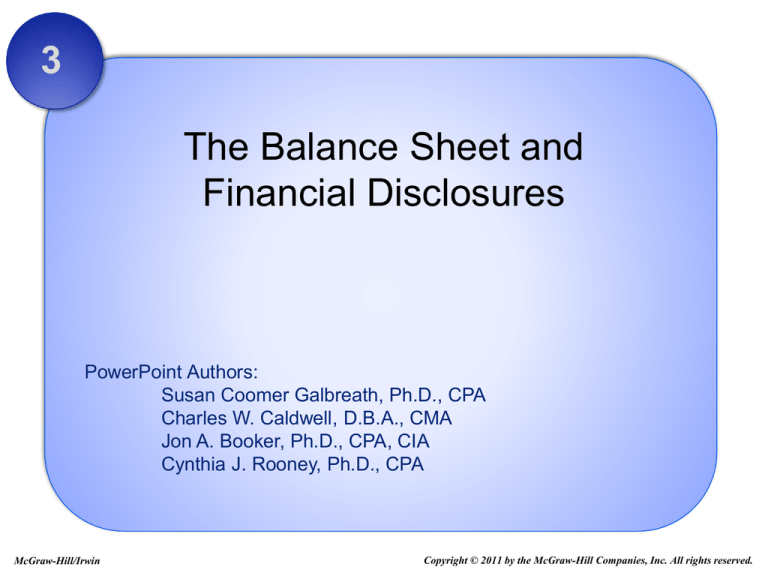
3
The Balance Sheet and
Financial Disclosures
PowerPoint Authors:
Susan Coomer Galbreath, Ph.D., CPA
Charles W. Caldwell, D.B.A., CMA
Jon A. Booker, Ph.D., CPA, CIA
Cynthia J. Rooney, Ph.D., CPA
McGraw-Hill/Irwin
Copyright © 2011 by the McGraw-Hill Companies, Inc. All rights reserved.
The Balance Sheet
Reports a company’s financial position on a particular date.
Limitations:
• The balance sheet does not
portray the market value of
the entity as a going concern
nor its liquidation value.
• Resources such as
employee skills and
reputation are not recorded
in the balance sheet.
3-2
Usefulness:
• The balance sheet describes
many of the resources a
company has for generating
future cash flows.
• It provides liquidity
information useful in
assessing a company’s
ability to pay its current
obligations.
• It provides long-term
solvency information relating
to the riskiness of a
company with regard to the
amount of liabilities in its
capital structure.
Classifications
Claims against
resources (Liabilities)
Resources
(Assets)
3-3
Remaining claims
accruing to owners
(Shareholders’ Equity)
Dell Inc.
Balance Sheet
(In millions)
January 30, 2009 February 1, 2008
Assets:
Current assets:
Cash and cash equivalents
$
8,352 $
7,764
Short-term investments
740
208
Accounts receivables, net
4,731
5,961
Financing receivables, net
1,712
1,732
Inventories, net
867
1,180
Other current assets
3,749
3,035
Total current assets
20,151
19,880
Noncurrent assets
Property, plant, and equipment, net
2,277
2,668
Investments
454
1,560
Long-term financing receivables, net
500
407
Goodwill
1,737
1,648
Purchased intangible assets, net
724
780
Other non-current assets
657
618
Total noncurrent assets
6,349
7,681
Total Assets
$
26,500 $
27,561
Assets are probable future economic benefits obtained or
controlled by a particular entity as a result of past
transactions or events.
3-4
Current Assets
Current
Assets
Will be converted
to cash or
consumed within
one year or the
operating cycle,
whichever is
longer.
3-5
1.
2.
3.
4.
5.
6.
Cash
Cash Equivalents
Short-term Investments
Receivables
Inventories
Prepaid Expenses
Cash equivalents
include certain
negotiable items
such as commercial
paper, money market
funds, and U.S.
treasury bills.
Operating Cycle of a
Typical Manufacturing Company
Use cash to acquire raw materials
Convert raw materials to finished
product
Deliver product to customer
Collect cash from customer
3-6
Noncurrent Assets
Noncurrent
Assets
Not expected to
be converted to
cash or
consumed within
one year or the
operating cycle,
whichever is
longer.
3-7
1. Investments
2. Property, Plant, &
Equipment
3. Intangible Assets
4. Other Assets
Noncurrent Assets
Investments
1.
2.
Not used in the operations of the
business.
Include both debt and equity securities of
other corporations, land held for
speculation, noncurrent receivables, and
cash set aside for special purposes.
©
1. Used in the operations of the
Intangible Assets
business but have no physical
substance.
2.
Include patents, copyrights,
and franchises.
3.
Reported net of accumulated
amortization.
Property, Plant, and Equipment
1.
Are tangible, long-lived, and used in the
operations of the business.
2.
Include land, buildings, equipment,
machinery, and furniture as well as
natural resources such as mineral mines,
timber tracts, and oil wells.
3.
Reported at original cost less
accumulated depreciation (or depletion
for natural resources).
3-8
Other Assets
1.
Include long-term prepaid
expenses and any noncurrent
assets not falling in one of the
other classifications.
Dell Inc.
Balance Sheet
(In milions)
Liabilities:
Current liabilities:
Short-term debt
Accounts payable
Accrued and other
Short-term deferred service revenue
Total current liabilities
Long-term debt
Long-term deferred service revenue
Other non-current liabilities
Total liabilities
January 30, 2009
$
$
February 1, 2008
113 $
8,309
3,788
2,649
14,859
1,898
3,000
2,472
22,229 $
225
11,492
4,323
2,486
18,526
362
2,774
2,070
23,732
Liabilities are probable future sacrifices of economic
benefits arising from present obligations of a particular
entity to transfer assets or provide services to other
entities as a result of past transactions or events.
3-9
Current Liabilities
Current
Liabilities
Obligations expected to be
satisfied through current
assets or creation of other
current liabilities within one
year or the operating cycle,
whichever is longer.
3 - 10
1.
2.
3.
4.
5.
Accounts Payable
Notes Payable
Accrued Liabilities
Unearned Revenues
Current Maturities
of Long-Term Debt
Long-term Liabilities
Long-Term
Liabilities
Obligations that
will not be
satisfied within
one year or
operating cycle,
whichever is
longer.
3 - 11
1.
2.
3.
4.
5.
Long-term Notes
Mortgages
Long-term Bonds
Pension Obligations
Lease Obligations
Dell Inc.
Balance Sheet
(In millions)
Stockholders' equity
Preferred stock and capital in excess of
$.01 par value; shares issued and
outstanding: none
Common stock and capital in excess of
$.01 par value; shares authorized: 7,000;
shares issued: 3,338 and 3,320, respectively;
shares outstanding: 1,944 and 2,060,
respectively
Treasury stock, at cost: 919 and 785 shares,
respectively
Retained earnings
Accumulated other comprehensive income
(loss)
Total stockholders' equity
January 30, 2009
February 1, 2008
$
$
$
-
-
11,189
10,589
(27,904)
20,677
(25,037)
18,199
309
4,271 $
Shareholders’ equity is the residual interest in the
assets of an entity that remains after deducting
liabilities.
3 - 12
(16)
3,735
U. S. GAAP vs. IFRS
There are more similarities than differences in balance
sheets prepared according to U.S. GAAP and those
prepared applying IFRS.
Some difference are highlighted below.
• Does not specify a minimum
list of items to be presented in
the balance sheet.
• Some U.S. companies use the
statement of financial position
title as well.
• Presents current assets and
liabilities before noncurrent
assets and liabilities.
3 - 13
• Specifies a minimum list of
items to be presented in the
balance sheet.
• Statement title changed to
statement of financial position.
• Does not prescribe the format
of the balance sheet, but
balance sheets prepared using
IFRS often report noncurrent
items first.
British Airways
Balance Sheet
At March 31, 2009
3 - 14
British Airways
Balance Sheet
At March 31, 2009
3 - 15
U. S. GAAP vs. IFRS
The FASB and IASB are working together on the Financial
Statement Presentation project to establish a common
standard for presenting information in the financial
statements.
Statement of Financial Position
Business
Operating assets and liabilities
Investing assets and liabilities
Financing
Financing assets
Financing liabilities
Income Taxes
Discontinued Operations
Equity
3 - 16
Each of the financial
statements will include
classifications by
operating, investing, and
financing activities, as
well as income taxes,
discontinued operations,
and equity (if needed).
Disclosure Notes
3 - 17
Summary of
Significant
Accounting Policies
Conveys valuable information
about the company’s choices from
among various alternative
accounting methods.
Subsequent Events
A significant development that
occurs after the company’s fiscal
year-end but before the financial
statements are issued or available
to be issued.
Noteworthy Events
and Transactions
Transactions or events that are
potentially important to evaluating
a company’s financial statements,
e.g., related parties, errors and
irregularities, and illegal acts.
Management Discussion and Analysis
Provides a biased but
informed perspective of
a company’s
operations, liquidity,
and capital resources.
3 - 18
Management’s Responsibilities
• Preparing the financial
statements and other
information in the annual
report.
• Maintaining and assessing the
company’s internal control
procedures.
3 - 19
Auditors’ Report
Expresses the auditors’ opinion
as to the fairness of
presentation of the financial
statements in conformity with
generally accepted accounting
principles.
Auditors’ reports must comply
with specifications of the Public
Companies Accounting
Oversight Board (PCAOB).
3 - 20
Auditors’ Opinions
3 - 21
Unqualified
Issued when the financial statements
present fairly the financial position,
results of operations, and cash flows
are in conformity with GAAP.
Qualified
Issued when there is an exception that
is not of sufficient seriousness to
invalidate the financial statements as a
whole.
Adverse
Issued when the exceptions are so
serious that a qualified opinion is not
justified.
Disclaimer
Issued when insufficient information
has been gathered to express an
opinion.
Compensation of Directors and
Top Executives
Proxy Statement Information
• Summary Compensation Table
–
–
–
–
–
Salary
Bonus
Stock Awards
Option Awards
Other Compensation
A proxy statement is sent each year
to all shareholders, usually in the
same mailing with the annual
report.
3 - 22
Using Financial Statement Information
3 - 23
Comparative Financial
Statements
Allow financial statement users to
compare year-to-year financial
position, results of operations, and
cash flows.
Horizontal Analysis
Expresses each item in the
financial statements as a
percentage of that same item in the
financial statements of another
year (base amount).
Vertical Analysis
Involves expressing each item in
the financial statements as a
percentage of an appropriate
corresponding total, or base
amount, within the same year.
Ratio Analysis
Allows analysts to control for size
differences over time and among
firms.





